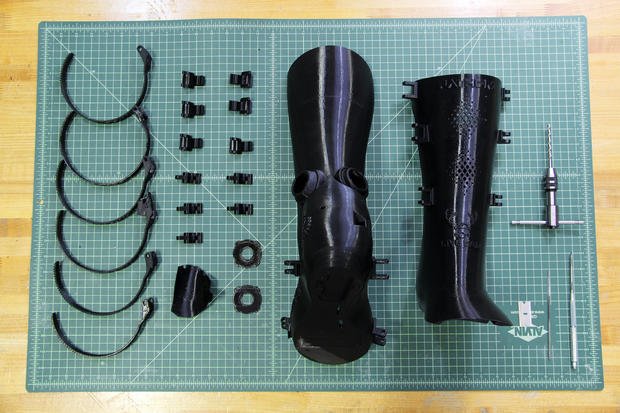Some of the components that went into the BoomCast, before everything was put together. Fathom
Medical casts are getting a whole lot smarter thanks to the BoomCast, a 3D-printed cast with sensors and electronics onboard to help doctors better track the healing process and provide improved mobility.
The BoomCast project was conceived of by Mike North, perhaps best known for his role on the Science Channel's "Outrageous Acts of Science" or his "In The Making" YouTube series. North broke his leg celebrating the life of his best friend Dan Fredinburg, the Google executive who was killed in an avalanche on Mount Everest back in April.
When North, a frequent traveler who's highly active, was fitted for a cast, his doctors gave him two options. Either he could be fitted with a walking cast that allowed him to move freely but not be able to travel due to potential swelling, or they could cut the cast in half to eliminate swelling issues, but he'd be bound to crutches.
And here's the finished product on Mike North's foot. Fathom
Neither option sounded pleasant to North, so he turned to the folks at Fathom Studio, a 3D-printing and additive manufacturing company, for help. Over the course of a couple of days, the Fathom team took a scan of North's leg and created a so-called BoomCast custom-fitted to his leg that would allow him to travel and bear weight.
Of course, this was no ordinary cast, and North and the Fathom crew equipped the BoomCast with a host of sensors, lights and speakers to gather data and promote healing. The BoomCast is equipped with the Intel Edison chipset -- a postage stamp-sized processor geared toward the maker and Internet of Things markets -- which gives the cast its computational prowess.
The sensors feeding the Edison include a gyroscope, accelerometer, magnetometer and a few integrated pressure sensors, which combine to measure things like North's leg movements and how much his leg is swelling. Data collected are fed to Google's Firebase in real-time, where they can be shared with North's doctor, who can use this information to provide better care to his patient.
Related Links
Tears of joy: 3D printing lets blind mom-to-be 'see' her son
Simple but ingenious invention takes the ouch out of injections
Invention lets newborns in incubators feel mom's heartbeat
3D-printed cast uses ultrasound to speed healing
In addition to providing protection and transmitting data, BoomCast also serves as a sort of entertainment device. The makers fitted BoomCast with speakers that were intended to provide sonic healing functionality, but North ended up using them to crank out some tunes to elevate his mood -- something he says his friend Dan would probably do as well.
Don't expect to see the BoomCast become a consumer product anytime soon, however, as it's more a proof of concept that these types of things are possible in devices like medical casts. The team has made the project open-source -- meaning that all of the information and designs the team use is available for others to take to create new, better products in the future.
With these advancements and others, it's only a matter of time before casts and other medical devices get a whole lot smarter. Be sure to check out the video below to see how the BoomCast was designed and built, and visit Fathom's page for even more info on the project.
Fuente: news.yahoo.com
